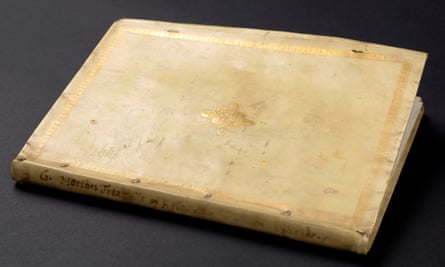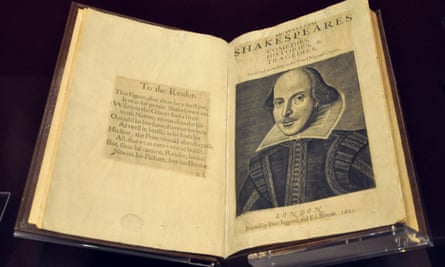Plagiarism software more commonly used to check student essays for overly assiduous borrowings has uncovered a long-forgotten, handwritten document from 1576 as the possible source for more than 20 monologues and passages from Shakespeare’s plays.
Independent scholar Dennis McCarthy and LaFayette College professor June Schlueter used WCopyfind software to compare passages from Shakespeare’s plays with George North’s 1576 unpublished manuscript, A Brief Discourse of Rebellion, about the dangers of rebelling against a king. They were able to trace more than 20 passages back to the essay, including Gloucester’s opening soliloquy in Richard III, Macbeth’s comparison of dog breeds to different classes of men, the Fool’s Merlin prophecy in King Lear, and the events surrounding Jack Cade’s fatal fight with Alexander Iden in Henry VI.
“Until now, no Shakespeare scholar has studied the manuscript, and it has probably remained little read. Yet, as our analysis has revealed, Discourse is not merely the only uniquely existent, evidently uncopied document to have had a substantial impact on the canon; it is one of the most influential Shakespearean source texts in any form,” they write in a new book, A Brief Discourse of Rebellion and Rebels by George North, which is published on 16 February by Boydell & Brewer, in collaboration with the British Library. “In terms of the number of plays, scenes and passages affected, the scope of the manuscript’s influence likely exceeds all other known Shakespearean sources, excepting only the Chronicles of Hall and Holinshed and Thomas North’s Plutarch’s Lives.”

In the Duke of Gloucester’s opening monologue, and a passage from Discourse, for example, the scholars and their software found that each contained “a tight juxtaposition of the same eight terms: glass, proportion, fair, feature, deformed, world, shadow, Nature.” The words occur within 77 words in Discourse and within 92 in Richard III – running them through a searchable database of more than 60,000 early English books, no other work contained the same eight words in passages of up to 200 words.
Furthermore, when just four words were considered – proportion, glass, feature and fair, which occur within a 31-word cluster in Shakespeare and a 16-word cluster in North – no other work in the database used the words in such close formation. “While it may seem to some at first glance that anyone writing about a glass is liable to use proportion, fair, and feature in the same passage, this is no longer a matter of conjecture … no one else did,” they write, adding that “before digitisation, scholars simply could not conduct searches in a comprehensive and objective fashion”.
McCarthy and Schlueter say that “the likelihood of Shakespeare juxtaposing these four shared terms by chance is less than one in a billion”, and that “even if by sheer chance Shakespeare hit these first four words, he still then has to match the next four words: Nature, shadow, deformed, world. This would be like hitting a national lottery twice in a row.”
They also show how details of the final hours of the rebel Jack Cade in Shakespeare’s Henry VI, Part II, including Cade eating grass because he is starving, and his corpse later being eaten by crows, mirror North’s poem about Cade’s death. The details appear in no other accounts of the rebel’s death.

McCarthy was moved to track down the manuscript of Discourse after spotting a mention of it in a 1927 catalogue of rare books where it was described as “an original and unknown work”. He and Schlueter searched for a year for the document, before it was eventually discovered in the British Library.
“It’s showing why you should never rebel against a king. It was an important ass-kissing thing to do … he’s trying to show ‘hey I’m behind the Elizabethan aristocracy,’” said McCarthy of the North text. “Shakespeare used it for his own plays, particularly plays dealing with rebellion. It solves a lot of riddles scholars have debated.”
The reaction to the discovery has been mixed. “New sources for Shakespeare do not turn up every day ... This is a truly significant one that has not heretofore been studied or published. The list of passages now traced back to this source is impressive,” said professor David Bevington of the University of Chicago.
But the Shakespeare scholar Sir Brian Vickers, who himself used plagiarism software to discover that Edward III was possibly a collaboration between Shakespeare and Thomas Kyd, was less convinced.
“I’ve only read parts of McCarthy’s book, but I think he has made a good case for Shakespeare having read this work. He tends to overstate his case, and finds significance in tiny details that can be explained by other factors,” said Vickers. “He has previously shown that Shakespeare knew other works by Sir Thomas North than his famous translation of Plutarch’s Lives. But, instead of taking this as further evidence of Shakespeare’s remarkable memory, in 2011 he published a book, North of Shakespeare, which claimed that North was the true author of Shakespeare’s plays. Scholars are now rather sceptical of his work.”
UCL English professor John Mullan was also cautious about the significance of the discovery. “This book might well have been read by Shakespeare,” said Mullan. “But there’s an eight-volume hardback work about sources of Shakespeare. And it’s a chastening experience – when you look at a particular play, Henry IV Part I for example, it has nine lengthy chunks from different works. They’re labelled as source, or possible source, or probable source, or historical analogue, or analogue. There are different degrees of ‘sourciness’.”

Comments (…)
Sign in or create your Guardian account to join the discussion